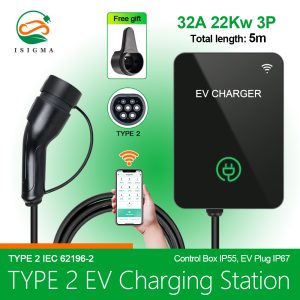
Electric vehicles (EVs) have been widely accepted by users due to their excellent driving experience and extremely low electricity costs. The charging experience of EVs is an important factor that influences user satisfaction. Charging methods for electric vehicles can be divided into two categories: AC ev charger and DC fast charger . Regarding AC ev charger, it can be further categorized into AC charging stations and onboard charging guns. Onboard charging guns, which are almost standard for electric and plug-in hybrid vehicles on the market, are commonly used by EV users for AC slow charging. When users encounter charging failures and cannot quickly diagnose the problem, they often become anxious, which greatly reduces their trust in electric vehicles.
This article takes the electric vehicles produced by SAIC-GM-Wuling Automobile (SGMW) as an example to analyze and propose corresponding solutions for common AC ev charger failures frequently encountered by EVs.
AC Charging Principle Pure electric vehicles and plug-in hybrid vehicles are equipped with AC slow charging systems. External AC power supply equipment (AC charging stations or onboard AC charging guns) supplies high-voltage AC power to the vehicle's onboard charger through the AC charging socket. The onboard charger then converts the high-voltage AC power into high-voltage DC power to charge the traction battery. Under normal charging conditions, when the vehicle is connected to an external power source, the instrument panel displays charging connection indicators and charging progress indicators, indicating that the vehicle is charging properly. If any abnormalities occur in the displayed indicators, it can be identified as a charging failure.
Types of Failures and Troubleshooting Methods Based on the AC charging principle mentioned above, the AC charging system of an electric vehicle consists of several components, including the AC charging gun, AC charging socket, traction battery, lead-acid battery, and wiring harness. With the involvement of numerous parts and human-operated processes during the charging operation (such as applying the handbrake and inserting the charging gun), AC charging failures can be caused by component malfunctions, systemic issues, or user errors. The wide range of factors makes it difficult to analyze and list all possible failures. Therefore, this article focuses on summarizing and analyzing common failure issues that occur during the AC ev charger process and proposes troubleshooting methods.
Systemic Failure Investigation and Handling Methods After eliminating possibilities such as vehicle low battery, abnormal external power supply, abnormal parking signal, and other high-voltage-related faults, if charging is still not possible, the real-time data stream of the onboard charger (OBC) module can be read using a vehicle diagnostic system (VDS). This helps verify the CC signal (charging connection signal), CP signal (charging connection guidance duty cycle), charging voltage, and current data corresponding to the vehicle connection and power supply status. If intermittent charging failure occurs, it is generally caused by abnormal external power voltage or poor grounding. It is recommended to connect the three-pronged charging gun to the external power supply (without connecting it to the vehicle) when the failure occurs again. If the charging gun indicator exhibits abnormalities, there is a high probability of power supply or charging gun failure, and it can be directly replaced with a normal charging gun to verify if the issue lies with the power supply.
As the market for electric vehicles continues to grow, quality issues associated with EVs are gradually being exposed. Charging failure, particularly the inability to charge, has become a major concern for many car users. It significantly affects users' trust in vehicle quality and automotive companies. In order to enhance the charging experience for EV users and address the frequent charging issues they encounter, this article ac ev charger takes the electric vehicles produced by SGMW as an example to summarize and analyze common types of AC ev charger charging failures. It presents a systematic approach for troubleshooting and provides solutions, which can be valuable for EV users and the automotive repair service industry.





